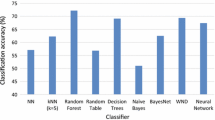Abstract
This study investigates the writing stylechange of two Turkish authors, Çetin Altanand Yaşar Kemal, in their old and newworks using respectively their newspapercolumns and novels. The style markers are thefrequencies of word lengths in both text andvocabulary, and the rate of usage of mostfrequent words. For both authors, t-tests andlogistic regressions show that the length ofthe words in new works is significantly longerthan that of the old. The principal componentanalyses graphically illustrate the separationbetween old and new texts. The works arecorrectly categorized as old or new with 75 to100% accuracy and 92% average accuracy usingdiscriminant analysis-based cross validation. The results imply higher time gap may havepositive impact in separation andcategorization. For Altan a regressionanalysis demonstrates a decrease in averageword length as the age of his column increases. One interesting observation is that for oneword each author has similar preference changesover time.
Similar content being viewed by others
References
Altan Ç. (1997-2001) ¸ Seytanİn Gör Dediİi. Sabah Newspaper (http://www.sabah.com.tr).
Baayen, R.H. (2001) Word Frequency Distributions. Kluwer Academic, Dordrecht, Boston.
Baayen H., Van Halteren H., Tweedie F. (1996) Outside the Cave of Shadows: Using Syntactic Annotation to Enhance Authorship Attribution. Literary and Linguistic Computing, 11(3), pp. 121–131.
Binongo J.N.G., Smith M.W.A. (1999) The Application of Principal Component Analysis to Stylometry. Literary and Linguistic Computing, 14(4), pp. 445–466.
Çiftlikçi, R. (1997) Ya¸sar Kemal Yazar-Eser-Ñslup. Türk Tarih Kurumu Basİmevi, Ankara.
Fayyad U., Piatetsky-Shapiro G., Smyth P. (1996) The KDD Process for Extracting Useful Knowledge from Volumes of Data. Communications of the ACM, 39(11), pp. 27–34.
Foltz P.W., Dumais S.T. (1992) Personalized Information Delivery an Analysis of Information Filtering Methods. Communications of the ACM, 35(12), pp. 51–60.
Forsyth R.S., Holmes D.I. (1996) Feature-finding for Text Classification. Literary and Linguistic Computing, 11(4), pp. 163–174.
Hakkani-Tür Z. (2000) Statistical Modeling of Agglutinative Languages. Ph.D. Dissertation, Department of Computer Engineering, Bilkent University, Ankara, Turkey.
Heaps H.S. (1978) Information Retrieval Computational and Theoretical Aspects. Academic Press Inc., New York, New York.
Holmes D.I., Singh S. (1996) A Stylometric Analysis of Conversational Speech of Aphasic Patients. Literary and Linguistic Computing, 11(3), 133–140.
Holmes D.I., Forsyth R.S. (1995) The Federalist Revisted: New Directions in Authorship Attribution. Literary and Linguistic Computing, 10(2), pp. 111–1127.
Holmes D.I. (1994) Authorship Attribution. Computers and the Humanities, 28(2), pp. 87–106.
Holmes D.I. (1985) The Analysis of Literary Style-A Review. Journal of the Royal Statistical Society, Series A, 148(4), pp. 328–341.
Jain A.K., Murty M.N., Flynn P.J. (1999) Data Clustering: A Review. ACM Computing Surveys, 30(3), pp. 264–323.
Kemal Y. (1998) Fİrat Suyu Kan Akİyor Baksana. Adam Yayİnlarİ, İstanbul.
Kemal Y. (1971) Bin Bİgalar Efsanesi. Cem Yayİnevi, İstanbul.
Kessler B., Geoffrey N, Schutze H. (1997) Automatic Detection of Text Genre. Proceedings of the 35th Annual Meeting of the Association for Computational Linguistics and 8th Conference of the European Chapter of the Association for Computational Linguistics, Madrid, pp. 32–38.
Köksal A. (1973) Automatic Morphological Analysis of Turkish. Ph.D. Dissertation, Hacettepe University, Ankara, Turkey.
Kucera H., Francis W.N. (1967) Computational Analysis of Present-Day American English. Brown University Press, Rhode Island.
Martindale C., Tuffin P. (1996) If Homer is the Poet of the Iliad, then He may not be the Poet of the Odyssey. Literary and Linguistic Computing, 11(3), pp. 109–120.
Naci F. (1999) Yüzyİlİn 100 Türk Romanİ. Adam Yayİnlarİ, İstanbul.
Ney H., Essen U., Kneser R. (1994) On Structuring Probabilistic Dependences in Stochastic Language Modeling. Computer Speech and Language, 8(1), pp. 1–38.
Oflazer K. (1994) Two-level Description of Turkish Morphology. Literary and Linguistic Computing, 9(4), pp. 137–149.
Redhouse (1979) Redhouse Yeni Türkçe-İngilizce Sözlük (New Redhouse Tonary). Redhouse Press, İstanbul.
Rudman, J. (1998) The State of Authorship Attribution Studies: Some Problems and Solutions. Computers and the Humanities, 31(4), pp. 351–365.
Sedelow S.Y. (1970) The Computer in the Humanities and Fine Arts. ACM Computing Surveys, 2(2), pp. 89–110.
Solak A., Oflazer K. (1993) Design and Implementation of a Spelling Checker for Turkish. Literary and Linguistic Computing, 8(3), pp. 113–130.
Stamatatos E., Fakotakis N., Kokkinakis G. (2001) Computer-based Authorship Attribution without Lexical Measures. Computers and the Humanities, 35(2), pp. 193–214.
Tallentire D.R. (1972) An Appraisal of Methods and Models in Computational Stylistics, with Particular Reference to Authorship Attribution. Ph.D. Thesis, University of Cambridge.
Tanpİnar A.H. (1982) Huzur. Dergah Yayİnlarİ, İstanbul.
TNP (2000) Articles from Turkish Newspapers, www.nlp.cs.bilkent.edu.tr.
Tweedie F.J., Singh S., Holmes D.I. (1996) Neural Network Applications in Stylometry: The Federalist Paper. Computers and the Humanities, 30(1), pp. 1–10.
Whissell C.M. (1994) A Computer-program for the Objective Analysis of Style and Emotional Connotations of Prose-Hemingway, Galsworthy, and Faulkner Compared. Perceptual and Motor Skills, 79(22), pp. 815–824.
Williams D.C. (1975) Mendenhall's Studies of Word-Length Distribution in the Works of Shakespeare and Bacon. Biometrika, 62(1), pp. 207–212.
Zipf G.K. (1932) Selected Studies of the Principle of Relative Frequency in Language. Harvard University Press, Cambridge, MA.
Author information
Authors and Affiliations
Rights and permissions
About this article
Cite this article
Can, F., Patton, J.M. Change of Writing Style with Time. Computers and the Humanities 38, 61–82 (2004). https://doi.org/10.1023/B:CHUM.0000009225.28847.77
Issue Date:
DOI: https://doi.org/10.1023/B:CHUM.0000009225.28847.77




